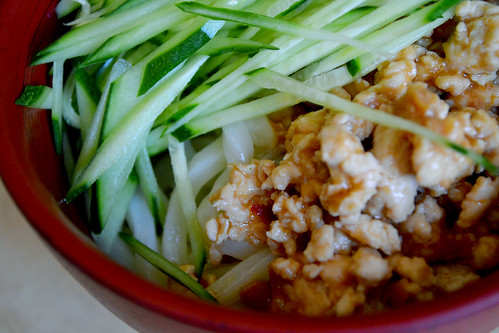
The one (and only) thing that I miss about the disgustingly humid temperatures in Tokyo is the arrival of cold noodle dishes on menus everywhere. During the hot months of June through September, I would convince myself that I deserved a daily reward of a big bowl of cold noodles for surviving each hot day. There are many
hiyashi-men (cold noodle) dishes, but the most common ones are
zaru soba, somen, hiyashi chuka and
nikumiso udon.
Hiyashi, means "chilled." A Japanese food-lover may be reminded of other dishes that use variations of that word including
hiyayakko (cold tofu),
ohiya (ice water),
hiya-sake (cold sake). During the hot summer months,
hiyashi and
hiya is a selling-point and people gravitate towards these menu items to temporarily relieve themselves from salaryman-stuffed subways and sweat-spattered sidewalks.
Since I have already posted recipes for
zaru soba and
somen on Japanify, I will start out this two-part series by introducing a recipe for
nikumiso udon (miso-meat udon). This sweet and spicy dish is a favorite among children because the flavors are simple. The textures in the dish are satisfying during the heat--crispy cucumbers and crumbly meat with slippery noodles.
The miso that many people use for
nikumiso is called
hatcho miso, which is popular in Nagoya. It is black in color and is fermented for much longer than regular
aka (red) and
shiro (white) misos. Since I don't regularly stock my fridge with
hatcho miso, I decided to use
aka miso for my
nikumiso udon. Although the meat mixture doesn't come out very dark in color, I was happy with the taste of my final product.
Nikumiso (Miso-Meat) Udon
INGREDIENTS
2 servings udon
1/2 lb. ground chicken or pork
1 tsp salad oil
1 tsp sesame oil
1 Japanese or Persian cucumber julienned
Sauce
2 tbsp miso (
aka or
hatcho)
1 tbsp sake
1 tbsp mirin
1 tbsp sugar
1 tsp chili sauce (hunan style or tobanjan)
METHOD
1. Julienne cucumbers and set aside in fridge.
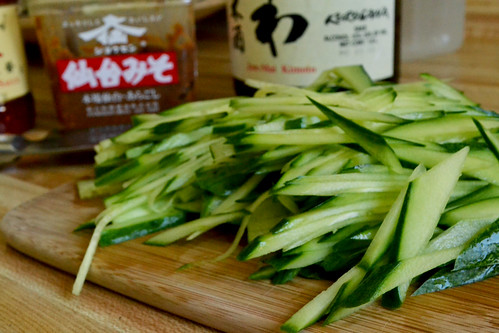
2. Mix ingredients for sauce in a bowl or cup.
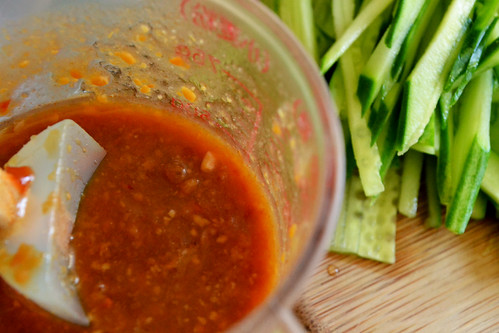
3. Bring a big pot of water to a boil. Cook udon.
4. Drain the udon and flush with cold water. Prepare an ice bath for the udon and place the strainer full of noodles in the ice bath.
5. In a pan, heat oil on high. Add the meat and break it up with a spatula. Fry the meat for 4-5 minutes. Dial down the heat to medium-low.
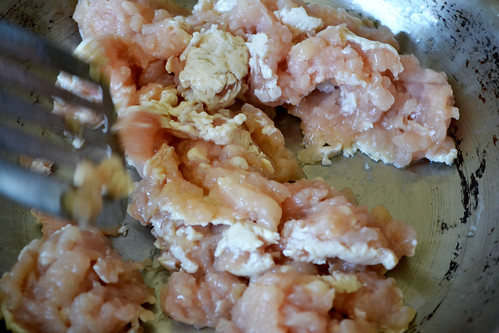
6. Add sauce to the pan with meat in it. Mix the meat around until it is well coated with the sauce. Turn off the heat.
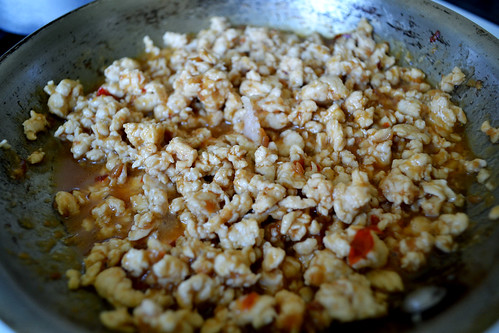
7. Strain the cold udon noodles.
8. Take a handful of noodles and place them into a bowl. Top with meat on one side and cucumbers on the other.
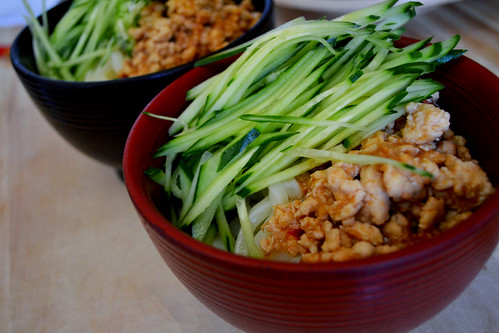
Mix it up well when eating so the flavors evenly coat each noodle.
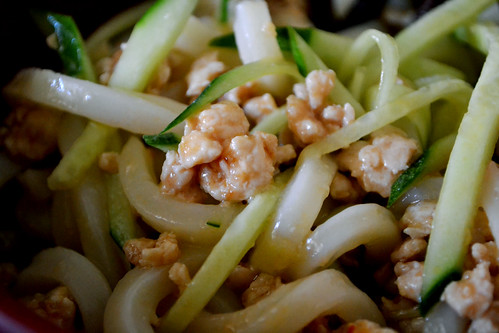
This dish is a real treat on a sunny day off. I can imagine inviting four or five friends over on a Sunday afternoon and enjoying
nikumiso udon and a six-pack of beer in the backyard.
Stay tuned next week for
Hiyashi Chuka (cold ramen salad), as we continue Japanify's Summer Slurp Series.
 The one (and only) thing that I miss about the disgustingly humid temperatures in Tokyo is the arrival of cold noodle dishes on menus everywhere. During the hot months of June through September, I would convince myself that I deserved a daily reward of a big bowl of cold noodles for surviving each hot day. There are many hiyashi-men (cold noodle) dishes, but the most common ones are zaru soba, somen, hiyashi chuka and nikumiso udon.
Hiyashi, means "chilled." A Japanese food-lover may be reminded of other dishes that use variations of that word including hiyayakko (cold tofu), ohiya (ice water), hiya-sake (cold sake). During the hot summer months, hiyashi and hiya is a selling-point and people gravitate towards these menu items to temporarily relieve themselves from salaryman-stuffed subways and sweat-spattered sidewalks.
Since I have already posted recipes for zaru soba and somen on Japanify, I will start out this two-part series by introducing a recipe for nikumiso udon (miso-meat udon). This sweet and spicy dish is a favorite among children because the flavors are simple. The textures in the dish are satisfying during the heat--crispy cucumbers and crumbly meat with slippery noodles.
The miso that many people use for nikumiso is called hatcho miso, which is popular in Nagoya. It is black in color and is fermented for much longer than regular aka (red) and shiro (white) misos. Since I don't regularly stock my fridge with hatcho miso, I decided to use aka miso for my nikumiso udon. Although the meat mixture doesn't come out very dark in color, I was happy with the taste of my final product.
Nikumiso (Miso-Meat) Udon
INGREDIENTS
2 servings udon
1/2 lb. ground chicken or pork
1 tsp salad oil
1 tsp sesame oil
1 Japanese or Persian cucumber julienned
Sauce
2 tbsp miso (aka or hatcho)
1 tbsp sake
1 tbsp mirin
1 tbsp sugar
1 tsp chili sauce (hunan style or tobanjan)
METHOD
1. Julienne cucumbers and set aside in fridge.
The one (and only) thing that I miss about the disgustingly humid temperatures in Tokyo is the arrival of cold noodle dishes on menus everywhere. During the hot months of June through September, I would convince myself that I deserved a daily reward of a big bowl of cold noodles for surviving each hot day. There are many hiyashi-men (cold noodle) dishes, but the most common ones are zaru soba, somen, hiyashi chuka and nikumiso udon.
Hiyashi, means "chilled." A Japanese food-lover may be reminded of other dishes that use variations of that word including hiyayakko (cold tofu), ohiya (ice water), hiya-sake (cold sake). During the hot summer months, hiyashi and hiya is a selling-point and people gravitate towards these menu items to temporarily relieve themselves from salaryman-stuffed subways and sweat-spattered sidewalks.
Since I have already posted recipes for zaru soba and somen on Japanify, I will start out this two-part series by introducing a recipe for nikumiso udon (miso-meat udon). This sweet and spicy dish is a favorite among children because the flavors are simple. The textures in the dish are satisfying during the heat--crispy cucumbers and crumbly meat with slippery noodles.
The miso that many people use for nikumiso is called hatcho miso, which is popular in Nagoya. It is black in color and is fermented for much longer than regular aka (red) and shiro (white) misos. Since I don't regularly stock my fridge with hatcho miso, I decided to use aka miso for my nikumiso udon. Although the meat mixture doesn't come out very dark in color, I was happy with the taste of my final product.
Nikumiso (Miso-Meat) Udon
INGREDIENTS
2 servings udon
1/2 lb. ground chicken or pork
1 tsp salad oil
1 tsp sesame oil
1 Japanese or Persian cucumber julienned
Sauce
2 tbsp miso (aka or hatcho)
1 tbsp sake
1 tbsp mirin
1 tbsp sugar
1 tsp chili sauce (hunan style or tobanjan)
METHOD
1. Julienne cucumbers and set aside in fridge.
 2. Mix ingredients for sauce in a bowl or cup.
2. Mix ingredients for sauce in a bowl or cup.
 3. Bring a big pot of water to a boil. Cook udon.
4. Drain the udon and flush with cold water. Prepare an ice bath for the udon and place the strainer full of noodles in the ice bath.
5. In a pan, heat oil on high. Add the meat and break it up with a spatula. Fry the meat for 4-5 minutes. Dial down the heat to medium-low.
3. Bring a big pot of water to a boil. Cook udon.
4. Drain the udon and flush with cold water. Prepare an ice bath for the udon and place the strainer full of noodles in the ice bath.
5. In a pan, heat oil on high. Add the meat and break it up with a spatula. Fry the meat for 4-5 minutes. Dial down the heat to medium-low.
 6. Add sauce to the pan with meat in it. Mix the meat around until it is well coated with the sauce. Turn off the heat.
6. Add sauce to the pan with meat in it. Mix the meat around until it is well coated with the sauce. Turn off the heat.
 7. Strain the cold udon noodles.
8. Take a handful of noodles and place them into a bowl. Top with meat on one side and cucumbers on the other.
7. Strain the cold udon noodles.
8. Take a handful of noodles and place them into a bowl. Top with meat on one side and cucumbers on the other.
 Mix it up well when eating so the flavors evenly coat each noodle.
Mix it up well when eating so the flavors evenly coat each noodle.
 This dish is a real treat on a sunny day off. I can imagine inviting four or five friends over on a Sunday afternoon and enjoying nikumiso udon and a six-pack of beer in the backyard.
Stay tuned next week for Hiyashi Chuka (cold ramen salad), as we continue Japanify's Summer Slurp Series.
This dish is a real treat on a sunny day off. I can imagine inviting four or five friends over on a Sunday afternoon and enjoying nikumiso udon and a six-pack of beer in the backyard.
Stay tuned next week for Hiyashi Chuka (cold ramen salad), as we continue Japanify's Summer Slurp Series.




Comments (9)
All it needs is a half boiled egg on top to make it perfect. And maybe a little nori. 😊
this is a great post. i was thinking of making one tonight. looking forward to Hiyashi Chuka post, too!
Oh wow Yoko, I wish I was at your house right now.
Thanks Mika and Tomo! Yes, stay tuned for next week’s hiyashi chuka post.
Just made nikumiso. I feel using somen may work better. I found udon to be a bit too thick. Oh, forgot to say, as usual I didn’t measure and mine was a lot thicker than what it looks on your post.
Yeah, it would probably work well with somen too, although somen seems pretty delicate for a meat-based sauce. Udon works well for me because both the udon and meat requires the same amount of mastication. I’ll try it with somen sometime though, might be good in the sense that the sauce will have more noodle surface area to cover.
the chewy bounce factor (hagotai) is really important to me too, which is why i never crave somen.
Just made this and it is my new favorite!!! Mine turned a bit orange, I think from the tobanjan. It’s like Mabo Udon, hoorayyyy!!!
I also added ginger to mine, and dried chili. It is spicy.
One thing—Hideko advised me once to not cook with sesame oil, because it is not good for you. Instead, she pours a bit over the top, at the very END of stir frying anything, for the sesame aroma to come through. She says that this way, the sasame flavor comes through, without all the sesame oil heaviness from cooking with it.
Not sure if this is a correct technique, or if actually cooking with sesame oil is actually best for other reasons besides just the taste.
Thoughts?
I totally made this after I saw a picture of it posted on facebook. I could not resist. It was amazing. Cucumbers are back in season at the farmer’s market too, so I used some of my homemade pickles. I also used pork from the River Dog Farm (who feeds their pigs ice cream from Three Twins!!! ). Such a delicious meal I had.
Also, I just discovered the best udon noodles I could buy at Berkeley Bowl (the one on Oregon Street). They are the ones in the freezer that come four in a pack. They are so chewy and satisfying to eat. Definitely try them if you have not.